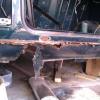Me again folks,
Getting lots of Q&A done today ![]() Dunno if this is 'normal', hence the question, but if I jack up the front of the mini to do anything, then after I drop it back down, there is quite a bit of positive camber on the front wheels. After running up and down the road a bit, it goes back to normal. Is this common on minis, or does it indicate slop somewhere that shouldn't be there? I have replaced balljoints recently so I know they are good, and when I had it all in bits to do front cones, the top and bottom arms felt fine with no sign of play. I know that the suspension will settle back down and that an increase in suspension height creates camber, but just bouncing the car to settle the suspension height doesn't get rid of it - it takes a wee drive to get rid of.
Dunno if this is 'normal', hence the question, but if I jack up the front of the mini to do anything, then after I drop it back down, there is quite a bit of positive camber on the front wheels. After running up and down the road a bit, it goes back to normal. Is this common on minis, or does it indicate slop somewhere that shouldn't be there? I have replaced balljoints recently so I know they are good, and when I had it all in bits to do front cones, the top and bottom arms felt fine with no sign of play. I know that the suspension will settle back down and that an increase in suspension height creates camber, but just bouncing the car to settle the suspension height doesn't get rid of it - it takes a wee drive to get rid of.
Cheers
Edited by carlukemini, 16 February 2015 - 05:03 PM.

















